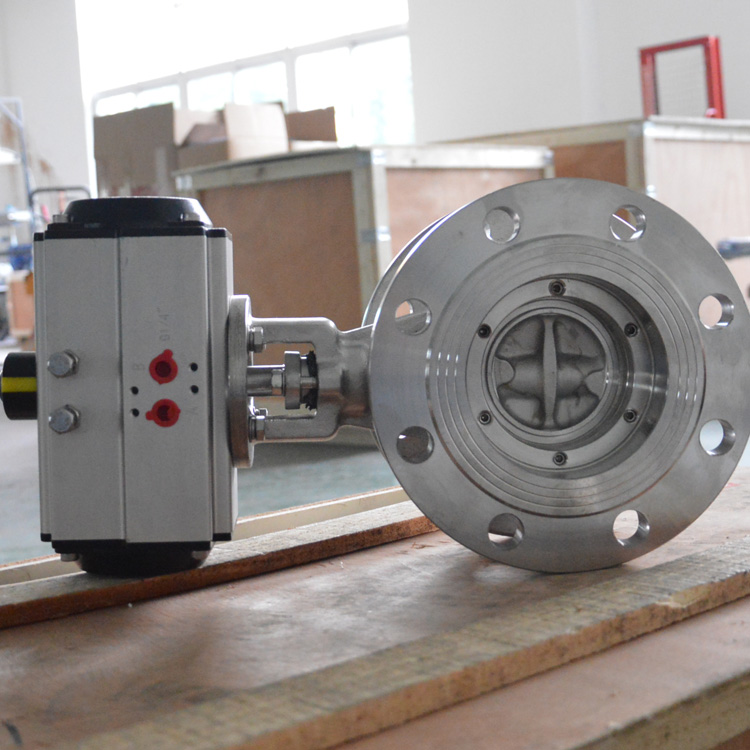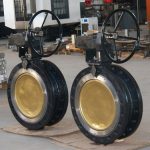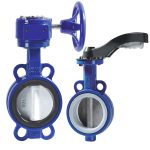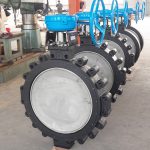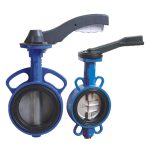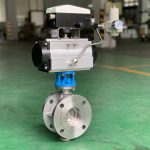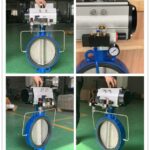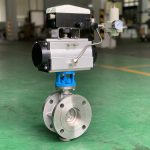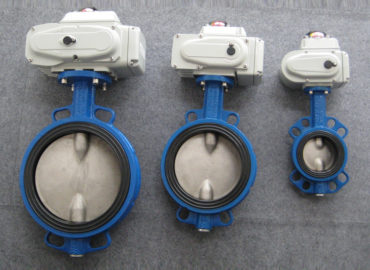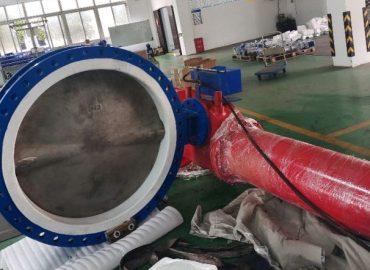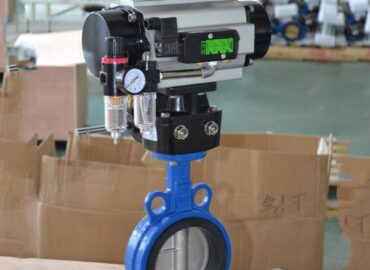In the realm of fluid control and management, valves play an integral role. Among the myriad of valve types, triple offset valves stand out due to their unique design and broad applications. This blog post delves into the world of triple offset valves, providing an in-depth look at their design and exploring the numerous industries they serve. From the oil and gas sector to the chemical industry and power plants, these valves have proven their worth. Whether you’re a seasoned engineer or someone simply interested in understanding more about this remarkable technology, this introduction to the design and applications of triple offset valves will provide valuable insights.
Introduction
Triple Offset Valves, also known as TOVs or triple eccentric valves, are an essential component in various industries due to their specialized design and wide-ranging applications. Introduced over 50 years ago, these valves have revolutionized the way we control fluid flow in systems. They are characterized by their three offsets – two are located to the centerline of the valve body and the third is set to the seating surface. This unique design allows for a metal-to-metal seal, ensuring zero leakage performance, which is a critical requirement in many industrial applications. In terms of application, TOVs are used in numerous sectors such as the oil and gas industry, chemical plants, and power generation facilities, among others. They handle everything from hot steam to abrasive, silting, scaling, or biological media. The design of the triple offset valves, featuring robust integral-to-body valve seats and optimized seating angles, enables them to handle extreme conditions and high pressure. Furthermore, the non-rubbing rotation feature of these valves contributes significantly to their longevity, making them a cost-effective solution. With the ability to provide repeatable sealing and an extended valve life, TOVs have become the go-to option for many engineers when it comes to choosing a valve that offers reliability, quality, and superior performance.
Brief explanation about triple offset valves
Triple offset valves, often abbreviated as TOVs, are a type of industrial valve known for their unique design and high-performance capabilities. The term “triple offset” refers to the three separate offsets incorporated into the valve’s design. The first offset involves the axis of rotation being placed off-center from the pipe’s centerline. The second offset is the shaft located behind the sealing surface, which allows for a cam-like action during opening and closing. The third offset is the geometry of the sealing surface, which is designed to eliminate friction during operation. These three offsets collectively contribute to the valve’s ability to provide bubble-tight shut-off, minimising wear and tear, and extending the valve’s lifespan. These features make triple offset valves an excellent choice for a wide range of industrial applications that require precise control over fluid flow.
Importance of valves in controlling fluid flow
Valves play a critical role in controlling fluid flow in a wide variety of industrial applications. They regulate the flow rate, pressure, and direction of liquids, gases, and slurries within a system or process. By opening, closing, or partially obstructing various passageways, valves can effectively control the flow of fluids. This functionality is vital for safety, efficiency, and operational effectiveness in many industries, including oil and gas, chemical processing, power generation, and water treatment, among others. The ability to control fluid flow can prevent overflows, manage pressure build-up, and ensure that systems operate within their specified parameters. Without valves, it would be nearly impossible to control the movement and direction of fluid in a controlled and safe manner, making them an indispensable part of any fluid handling system.

Understanding Valves: A Basic Overview
Valves are mechanical devices that control the flow and pressure within a system or process. They’re essentially the gatekeepers of fluid flow, opening, closing, or partially obstructing passageways to control the volume of fluid that passes through them. Valves can be categorized into several types, each designed with a specific purpose in mind and suited to different applications. Gate valves, for example, are used when a straight-line flow of fluid and minimum flow restriction are needed. Ball valves are excellent for shut-off applications and are easy to operate, while check valves allow fluid to flow in one direction and prevent backflow. Butterfly valves, on the other hand, are used for isolating or regulating the flow and are favored for their lightweight design and low cost. Then there are more specialized valves like the triple offset valves, which are prized for their ability to offer zero leakage and handle high-pressure, high-temperature situations. Understanding the basic function and types of valves is crucial in selecting the right valve for a particular application. It’s important to consider factors such as the nature of the fluid, operating pressure and temperature, necessary flow rate, and specific requirements of the system or process when choosing a valve.
Explanation about what valves are
Valves are mechanical devices that play a crucial role in controlling the flow of fluids – liquids, gases, and sometimes slurries – through a system or process. They function by opening, closing, or partially obstructing various passageways, thereby regulating the volume, pressure, and direction of the fluid flow. Valves can be manually operated or automated, and they come in a wide variety of designs, each suitable for a specific purpose. From simple taps in our homes to complex valve systems in industrial plants, valves are integral components in almost any system where fluid flow is involved. Their essential function in regulating fluid flow ensures the safe and efficient operation of many processes across a broad spectrum of industries.
Different types of valves and their uses
Valves come in a variety of types, each designed to perform a specific function within a system or process. Gate valves, for instance, are typically used in systems where a straight-line flow and minimal flow restriction are needed. They are ideal for on-off, non-throttling applications. Globe valves, on the other hand, are perfect for regulating flow in a pipeline. They provide better shut-off as compared to gate valves and are widely used in industries where flow needs to be regulated frequently. Ball valves are known for their quick shut off capabilities and are commonly used in both domestic and industrial applications. Butterfly valves, which consist of a disc attached to a rotating shaft, are used for isolating or regulating the flow, and are preferred for their lightweight design and cost-effectiveness. Check valves allow fluid to flow in only one direction, preventing backflow in systems. Meanwhile, plug valves are used in many industries to stop or start fluid flow with a quarter-turn motion. Each type of valve serves a unique purpose, and understanding their uses can help in selecting the right valve for a specific application.
The Concept of Triple Offset Valves
Triple Offset Valves (TOVs), also known as triple eccentric valves, are a specific type of industrial control valve that have been designed with three distinct offsets to provide optimal performance and longevity. The concept of the triple offset design is rooted in the goal to eliminate friction and increase sealing performance. The first offset is the centerline of the disc/seat seal interface, which is set off from the centerline of the bore. This offset allows for a 360-degree sealing surface. The second offset involves the shaft of the valve, which is placed behind the sealing plane to allow complete sealing around the entire seat. The third and final offset is the inclination of the sealing surface, which ensures minimal wear and tear as the valve opens and closes. This unique design allows TOVs to offer zero leakage, making them an ideal choice for applications where leakage can have serious consequences, such as in the oil and gas industry. Further, the frictionless operation of these valves reduces wear and tear, enhancing their lifespan and reducing maintenance requirements. The concept of triple offset valves is thus a testament to engineering innovation, offering solutions to some of the common problems associated with traditional valves.

Detailed description of triple offset valves
Triple offset valves, often referred to as triple eccentric valves, are a specialized type of valve designed with three different offsets to enhance performance and longevity. The first offset is the centerline of the disc/seat seal interface, which is deliberately deviated from the centerline of the pipe or bore. This deviation allows for a complete 360-degree sealing surface. The second offset is the placement of the shaft, which is positioned behind the plane of the sealing surface. This configuration permits a cam-like action during opening and closing, ensuring complete sealing around the entire seat. The third offset involves a conical inclination of the sealing surface, which eliminates friction during operation. This clever design enables the triple offset valves to achieve zero leakage, making them an excellent choice for applications where leakage can lead to serious consequences. Furthermore, the absence of friction reduces wear and tear, thus extending the lifespan of these valves and minimizing maintenance requirements.
Discussing the three offsets in triple offset valves
The unique design of triple offset valves incorporates three distinct offsets, each contributing to the valve’s superior performance. The first offset is related to the seal axis, which is placed off-center from the pipe or bore axis. This design creates a seal that can achieve a full 360-degree surface contact, facilitating a tight shut-off. The second offset involves the placement of the stem axis, which is positioned behind the seal plane. This configuration enables a cam-like action as the valve opens and closes, ensuring complete sealing around the entire seat. The third offset is the most complex and involves angling the sealing surface in a conical shape, which is inclined away from the direction of flow. This conical inclination allows for a virtually frictionless operation, eliminating wear and tear on the seal during opening and closing. Together, these three offsets in a triple offset valve ensure optimal sealing, zero leakage, and extended valve life.
Why triple offset valves are unique compared to other valve types
Triple offset valves (TOVs) hold a unique place in the wide spectrum of industrial valves due to their distinct design and superior performance. Unlike traditional valves, TOVs feature three separate offsets that together enable a virtually frictionless operation and a tight, bubble-proof seal. The first two offsets are geometric and relate to the positioning of the seal axis and stem axis, while the third offset involves angling the sealing surface in a conical shape. This specific design not only allows for full 360-degree sealing but also ensures zero leakage, which is a significant advantage over other valve types. Moreover, the frictionless operation reduces wear and tear on the valve, resulting in lower maintenance requirements and longer service life. These unique characteristics make TOVs particularly suitable for demanding applications, especially in industries where leakage can lead to serious safety issues or operational inefficiencies. Therefore, in terms of reliability, efficiency, and longevity, triple offset valves stand out from other types of valves.
Design of Triple Offset Valves
The design of Triple Offset Valves (TOVs) is a marvel of engineering, specifically created to enhance performance, reduce wear and tear, and ensure zero leakage. The uniqueness of TOVs lies in the three separate offsets incorporated into their design. The first offset relates to the seal axis, which is positioned off-center from the pipe or bore axis. This offset allows for a 360-degree sealing surface, ensuring a tight shut-off when the valve is closed. The second offset involves the positioning of the stem axis behind the seal plane. This configuration enables a smooth, cam-like motion as the valve opens and closes, facilitating complete sealing around the entire seat. The third offset, which is the most complex, involves angling the sealing surface in a conical shape that is inclined away from the direction of flow. This inclination provides a virtually frictionless operation, eliminating wear and tear on the seal during opening and closing. The combination of these three offsets results in a valve design that ensures optimal sealing, zero leakage, reduced maintenance, and extended service life. The material used for the sealing components also plays a crucial role in the valve’s performance. Metal seats are often used for high-temperature applications, while softer materials like PTFE might be used for lower temperatures. In summary, the design of triple offset valves is a testament to the continuous advancements in valve technology, offering solutions to some of the common challenges associated with traditional valve designs.
Discussing the design elements of triple offset valves
Triple Offset Valves (TOVs) are engineered with a unique design that includes three distinct offsets, each contributing to their superior performance and longevity. The first offset involves the positioning of the seal axis, which is intentionally set off-center from the pipe or bore axis. This offset allows for a 360-degree sealing surface, ensuring a tight shut-off when the valve is in the closed position.
The second offset is related to the placement of the stem axis, situated behind the seal plane. This specific configuration facilitates a cam-like motion when the valve opens or closes, ensuring complete sealing around the entire seat and eliminating any rubbing action of the sealing elements during the 90 degrees of rotation.
The third offset, arguably the most critical, involves the conical inclination of the sealing surface, which is angled away from the direction of flow. This design completely eliminates friction during operation, leading to minimal wear and tear on the seal during the opening and closing of the valve.
Additionally, the geometry design of the sealing components, each machined into an offset conical profile, contributes to the valve’s unique characteristics. This unique design results in a bubble-tight shut-off and a metal-to-metal seal, ensuring zero leakage.
The combination of these three offsets and the careful design of the sealing components results in an uninterrupted sealing surface, minimizes wear between the seat and the seal, and extends the lifespan of the valve. The triple offset design truly sets these valves apart from other types in terms of efficiency, reliability, and longevity.
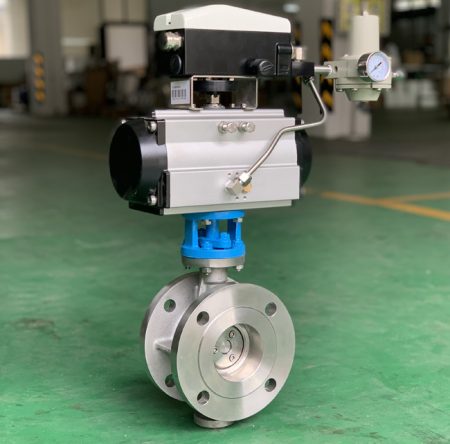
How the design contributes to the functionality of the valve
The distinctive design of Triple Offset Valves (TOVs) directly contributes to their exceptional functionality and performance. The first offset, which places the seal axis off-center from the pipe or bore axis, allows for a 360-degree sealing surface that ensures a tight shut-off when the valve is in the closed position. The second offset positions the stem axis behind the seal plane, enabling a cam-like motion during operation and ensuring complete sealing around the seat without any rubbing action. The third offset involves a conical inclination of the sealing surface, angled away from the direction of flow. This precise design element eliminates friction during operation, leading to minimal wear and tear on the seal during opening and closing of the valve. As a result, TOVs offer a virtually frictionless operation, zero leakage, reduced maintenance, and an extended service life. These elements combined make the triple offset valve highly efficient and reliable, particularly in industries where a secure seal and durable performance are critical. The design of TOVs is thus a prime example of how thoughtful engineering can significantly enhance the functionality of an industrial component.
Material used for construction and why
The construction material of Triple Offset Valves (TOVs) is a significant factor that contributes to their performance, durability, and application suitability. Typically, these valves are made from robust materials like stainless steel, carbon steel, or alloy steels. Stainless steel is often chosen for its excellent corrosion resistance, making it suitable for applications involving corrosive fluids or challenging environmental conditions. Carbon steel, on the other hand, offers high strength and durability at a more affordable cost, making it a popular choice for applications with less aggressive media. Alloy steels, including chrome-moly steel, are used when the valve needs to withstand high temperatures or pressures. In addition to the body material, the sealing components of TOVs are also critical. These can be made from metals for high-temperature applications or softer materials like PTFE for lower temperatures. The choice of construction material is thus a careful balance between the requirements of the application, including the type of fluid, operating temperature and pressure, and the overall cost-effectiveness.
Applications of Triple Offset Valves
Triple Offset Valves (TOVs) are known for their superior performance, zero leakage, and long service life, making them suitable for a wide range of applications across various industries. In the oil and gas industry, TOVs are used in critical isolation services where a tight shut-off is necessary to prevent leakage of hazardous fluids. They are also employed in on-off and control applications in gas processing plants, offshore platforms, and refineries due to their high reliability and ability to withstand extreme temperatures and pressures.
In the chemical industry, TOVs are utilized for handling aggressive, corrosive, and toxic media, thanks to their robust construction materials, such as stainless steel or alloy steels, which offer excellent resistance against corrosion. They are also often used in cryogenic applications given their capability to maintain a tight seal even at extremely low temperatures.
In the power generation sector, TOVs find their place in steam isolation applications due to their ability to handle high temperatures and pressures, and the frictionless operation that minimizes wear and tear. They are also used in water treatment facilities for isolation and control purposes, given their ability to offer bubble-tight shut-off.
Moreover, in the pulp and paper industry, TOVs are used due to their ability to handle slurry applications efficiently. They can also be found in shipbuilding, district heating, and HVAC systems, among others. The versatility of triple offset valves, owing to their unique design and construction, allows them to cater to a broad spectrum of demanding industrial applications, highlighting their importance in ensuring process safety and efficiency.
Industries where triple offset valves are commonly used
Triple Offset Valves (TOVs) are commonly used across a variety of industries due to their unique design that ensures zero leakage, minimal friction, and extended service life. One of the most prominent industries that utilize TOVs is the oil and gas industry, where these valves are employed for various processes due to their ability to provide a tight shutoff, making them ideal for handling hazardous fluids. They are also found in petroleum refineries and gas processing plants, where they manage high-temperature and high-pressure environments effectively. In the power generation sector, TOVs are used in steam isolation applications due to their capability to withstand extreme temperatures and pressures. Additionally, chemical and petrochemical plants use TOVs because of their robust construction that can resist corrosive substances. Other industries that use TOVs include pulp and paper manufacturing, shipbuilding, and HVAC systems, among others, highlighting the versatility and wide-ranging applicability of these valves.
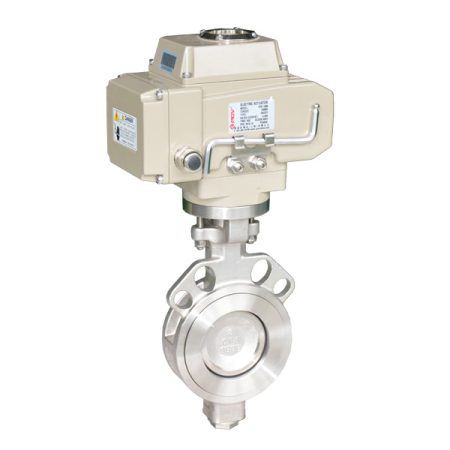
Specific applications within these industries
Within these various industries, Triple Offset Valves (TOVs) have specific applications that leverage their unique design and superior performance. In the oil and gas industry, TOVs are used in critical isolation services for preventing leakage of hazardous fluids. They also play a pivotal role in on-off and control applications within gas processing plants and offshore platforms. In the power generation sector, TOVs are employed in steam isolation applications where they handle high temperatures and pressures effectively. In chemical and petrochemical industries, these valves are used to manage aggressive, corrosive, and toxic substances due to their robust construction and excellent corrosion resistance. In the pulp and paper industry, TOVs handle slurry applications efficiently, while in shipbuilding, they are often utilized in fuel handling systems. Within HVAC systems, TOVs can be found in district heating plants and large-scale cooling systems where they provide reliable isolation and control of fluid flow. Thus, the specific applications of TOVs within these industries underscore their versatility and the vital role they play in ensuring process safety and efficiency.
Benefits of using triple offset valves in these applications
The use of Triple Offset Valves (TOVs) in these diverse applications offers several distinct benefits. One of the primary advantages is the bubble-tight shut-off that TOVs provide, ensuring zero leakage and enhancing safety, particularly in industries handling hazardous fluids. This characteristic is due to the unique triple offset design that eliminates friction during operation, which not only minimizes wear and tear on the sealing components but also contributes to the valve’s extended lifespan. The metal-to-metal sealing ensures compatibility with a wide range of media, including corrosive substances, making TOVs suitable for harsh environments found in chemical and petrochemical industries. Moreover, TOVs are known for their robustness and ability to withstand high temperatures and pressures, making them ideal for applications in the oil and gas and power generation sectors. Lastly, the lightweight design and ease of operation of TOVs contribute to reduced operational costs and energy efficiency. Therefore, the incorporation of TOVs into these applications brings significant operational advantages, contributing to increased process efficiency, safety, and cost-effectiveness.
Advantages and Disadvantages of Triple Offset Valves
Triple Offset Wafer Butterfly Valves (TOVs) offer several significant advantages, making them a preferred choice in various industrial applications. One of the primary advantages is the bubble-tight shut-off, which ensures zero leakage and significantly enhances safety – a critical factor in industries handling hazardous fluids. This feature is made possible by the unique triple offset design, which eliminates friction during valve operation, thereby minimizing wear and tear on the sealing components and contributing to the valve’s extended service life. Additionally, their metal-to-metal sealing provides compatibility with a wide range of media, including corrosive substances, making TOVs suitable for challenging environments found in chemical and petrochemical industries. They are also known for their robustness and ability to handle high temperatures and pressures, which makes them ideal for applications in the oil and gas and power generation sectors. Furthermore, their lightweight design and ease of operation contribute to reduced operational costs and increased energy efficiency.
However, despite these numerous advantages, TOVs do have some limitations. The complexity of the triple offset design makes these valves more expensive to manufacture compared to other valve types, which can be a deterrent for cost-sensitive projects. Additionally, while they are excellent for isolation purposes, TOVs may not be suitable for throttling applications due to the potential for damage to the seating surface. Lastly, although they can handle a wide range of media, they might not be suitable for some extreme conditions, such as highly abrasive or ultra-high temperature applications. Therefore, while TOVs offer a range of benefits, it’s crucial to consider their limitations and ensure they are the right fit for the specific application requirements.
Listing the advantages of triple offset valves
- Bubble-Tight Shut-off: Triple Offset Valves (TOVs) provide a bubble-tight shut-off, ensuring zero leakage. This is crucial in industries handling hazardous fluids where safety is paramount.
- Extended Lifespan: The unique triple offset design eliminates friction during operation, minimizing wear and tear on the sealing components. This contributes to an extended service life of the valve.
- Wide Range Compatibility: TOVs’ metal-to-metal sealing provides compatibility with a broad range of media, including corrosive substances. This makes them suitable for use in challenging environments found in various industries.
- High Temperature and Pressure Handling: TOVs are robust and can withstand high temperatures and pressures. This makes them ideal for applications in the oil and gas and power generation sectors.
- Reduced Operational Costs: The lightweight design and ease of operation of TOVs contribute to reduced operational costs. They require less torque to operate, which can lead to energy savings.
- Versatility: TOVs are versatile and can be used in a wide array of applications across different industries, catering to a broad spectrum of demanding industrial applications.
- Durability: Due to their sturdy construction, TOVs offer excellent durability, which can result in lower maintenance costs over time.
Discussing potential drawbacks or limitations
While Triple Offset Valves (TOVs) offer numerous advantages, they do come with certain limitations. One of the main drawbacks is the higher manufacturing cost associated with the complexity of their design. This can make them a less cost-effective choice for some projects. Another potential limitation is their suitability for throttling applications. Although TOVs excel in isolation services, they may not be the best choice for throttling due to potential damage to the seating surface from the high velocity flow. Additionally, while TOVs can handle a wide range of media and temperatures, they might not be suitable for extreme conditions such as highly abrasive substances or ultra-high temperature applications. Finally, their maintenance could be more complex compared to simpler valve designs, requiring specialized knowledge and potentially leading to longer downtime. Therefore, while TOVs are highly versatile and efficient, these potential drawbacks need to be considered when selecting a valve for a specific application.
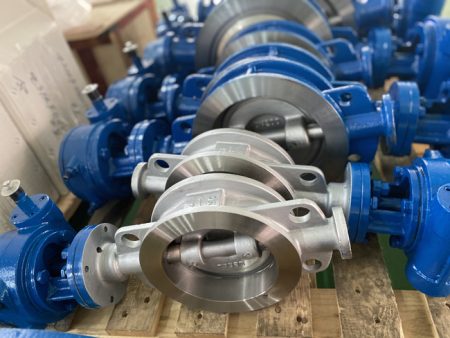
Comparisons with other types of valves
When comparing Triple Offset Butterfly Valve with other types of valves, several differences become apparent. For instance, compared to gate valves, TOVs provide a tighter seal and less friction during operation due to their triple offset design. This results in a longer lifespan and better performance in applications requiring zero leakage. However, gate valves are generally more cost-effective and simpler to manufacture. Compared to ball valves, TOVs offer superior performance in high temperature and pressure applications. They also require less operating torque, leading to energy efficiency. But, ball valves have the advantage in throttling services, where TOVs might not be the most suitable choice. Butterfly valves, on the other hand, share similarities with TOVs as they are both part of the quarter-turn valve family. However, TOVs have an edge in terms of providing a bubble-tight shut-off and handling higher pressure and temperature conditions. It’s important to note that while TOVs offer several advantages, the choice of valve type ultimately depends on the specific needs and conditions of the application.
Future Trends in Valve Technology
Future trends in valve technology are being driven by various factors such as technological advancements, evolving customer demands, and changes in the regulatory landscape. Here are a few key trends:
- Digitalization: The future of valves and valve manufacturing is moving towards digital solutions. This includes the use of augmented reality (AR) technologies to virtually teleport customers to the manufacturing site, improving collaboration and communication.
- Innovative Design Trends: New design features such as non-rotating stem globe design, seat arrangement, and seal-wielding of threaded seat ring are being incorporated into valve designs for improved performance and efficiency.
- Control Valve Automation: Advances in technologies that work in tandem with control valves are driving efficiencies, reducing downtime, and gathering more data for predictive maintenance and process optimization.
- Growth in Market Value: The global control valve market, valued at USD 6.3 Billion in 2021, is expected to reach a value of USD 19.3 Billion by 2028, indicating a growing demand for these essential components.
- Sustainability: As industries move towards more sustainable practices, the demand for energy-efficient and environmentally friendly valves will increase. This includes valves that minimize leakage and reduce energy consumption.
- Increased Use of Smart Valves: With the rise of Industry 4.0, smart valves equipped with sensors and wireless communication capabilities will become more prevalent. These valves provide real-time data on valve performance and health, enabling proactive maintenance and improved operational efficiency.
These trends indicate a bright future for valve technology, marked by innovation, digitalization, and an increased focus on efficiency and sustainability.
Current trends in valve technology
Current trends in valve technology are heavily influenced by the shift towards digitalization, automation, and sustainability. Here are a few key trends:
- Digitalization: The digital revolution is making its way into valve technology. This includes the use of technologies like augmented reality for virtual inspections, Internet of Things (IoT) for real-time monitoring of valve performance, and predictive analytics for proactive maintenance.
- Automation: Automation in valve manufacturing is gaining traction. Automated processes are helping manufacturers to increase their production rates, reduce human error, and improve the consistency of their products.
- Directional Control Valve Technology: Innovations in directional control valve technology are improving hydraulic systems’ efficiency and precision. These advancements are particularly beneficial in industries like oil and gas, where precise control of fluid flow is crucial.
- Smart Valves: With the rise of Industry 4.0, smart valves equipped with sensors and wireless communication capabilities are becoming more common. These valves can provide real-time data on valve performance and health, leading to improved operational efficiency and reduced downtime.
- Sustainability: As the industrial sector moves towards more sustainable practices, there’s an increased demand for energy-efficient and environmentally friendly valves. This includes valves that minimize leakage and reduce energy consumption.
- Agile Manufacturing: The valve manufacturing industry is moving towards more agile practices to quickly respond to market changes and customer demands. This includes adopting lean manufacturing techniques and flexible production systems.
These trends are shaping the future of valve technology, leading to improvements in efficiency, reliability, and sustainability.
Predicted future developments, focusing on triple offset valves
Looking ahead, the future of Triple Offset Valves (TOVs) is likely to be influenced by several key developments. As industries continue to prioritize efficiency and sustainability, we can expect advancements aimed at further enhancing the performance and environmental friendliness of these valves. This could involve the use of new materials or coatings that improve durability and reduce friction, leading to even longer service life and greater energy efficiency. Additionally, with the rise of digitalization and Industry 4.0, we may see an increase in ‘smart’ TOVs equipped with sensors and wireless capabilities. These smart valves would provide real-time data on valve performance and health, enabling predictive maintenance and reducing downtime. This data could also be used to optimize processes and improve overall operational efficiency. Furthermore, as industries continue to tackle more challenging applications, such as extreme temperatures or highly corrosive environments, there will likely be a demand for TOVs that can withstand these conditions without compromising on their tight shut-off capabilities. These predicted developments reflect the ongoing trend towards more efficient, reliable, and sustainable industrial practices.
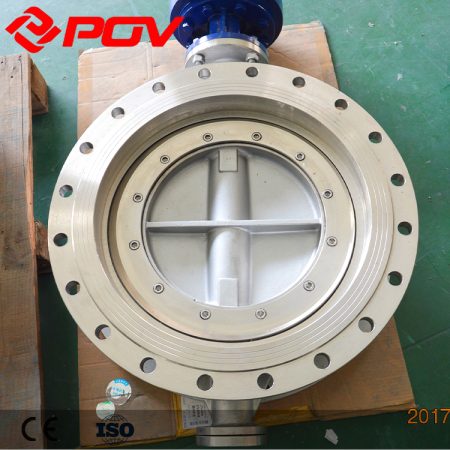
How these developments could impact industries
The predicted developments in Triple Offset Valves (TOVs) could have a significant impact on various industries. For instance, the oil and gas industry could benefit from more durable and efficient TOVs that can withstand extreme conditions, enhancing operational safety and reducing potential environmental risks. In the chemical industry, ‘smart’ TOVs would enable real-time monitoring of valve performance, leading to improved process control and product quality. The energy sector could also see benefits, as more energy-efficient TOVs would contribute to lower energy costs and reduced carbon emissions. Furthermore, industries like water treatment and food & beverage, where hygiene and cleanliness are paramount, could benefit from TOVs with improved sealing capabilities, reducing the risk of contamination. Overall, these developments could lead to enhanced operational efficiency, cost savings, and improved safety across multiple industries. They could also contribute to sustainability efforts, helping industries to reduce their environmental footprint and move towards greener practices.
Conclusion
In conclusion, Triple Offset Valves (TOVs) are a marvel of engineering design that serves an essential role in numerous industries. Their unique triple offset design offers several key advantages over traditional valve types, including a bubble-tight shut-off, reduced friction during operation, and an extended service life. Their versatility allows them to handle a wide range of media, temperatures, and pressures, making them suitable for many different applications.
However, like any technology, TOVs come with their own set of challenges and limitations. Their complex design can lead to higher manufacturing costs and more complicated maintenance procedures. Furthermore, while they excel in isolation services, they may not be the best choice for throttling applications or extreme conditions involving highly abrasive substances or ultra-high temperatures.
Despite these challenges, the future of TOVs looks promising. The trend towards digitalization, automation, and sustainability in the industrial sector is driving numerous advancements in valve technology. We can expect to see more ‘smart’ TOVs equipped with sensors and wireless capabilities, providing real-time data on valve performance and enabling predictive maintenance. Moreover, as industries continue to tackle more challenging applications, there will likely be a demand for TOVs that can withstand these conditions without compromising on their tight shut-off capabilities.
These developments could have significant implications for various industries. From the oil and gas sector to the chemical industry and beyond, improved TOVs could lead to enhanced operational efficiency, cost savings, and improved safety. They could also contribute to sustainability efforts, helping industries to reduce their environmental footprint and move towards greener practices.
In summary, TOVs represent an exciting area of valve technology that holds great potential for the future. As they continue to evolve and improve, we can look forward to seeing how they will shape the industries that rely on them. Whether you’re an engineer, a plant manager, or just someone interested in industrial technology, TOVs are a topic worth keeping an eye on.
Recap of the importance and benefits of triple offset valves
In recap, the importance and benefits of Triple Offset Valves (TOVs) cannot be overstated. Their unique design offers a multitude of advantages that make them an invaluable asset in various industrial applications. The ‘triple offset’ in their design ensures a tight, bubble-proof seal, reducing the risk of leakage and enhancing operational efficiency. This design also reduces wear and tear on the valve, leading to a longer service life and lower maintenance costs. TOVs are versatile, capable of handling a broad range of media, pressures, and temperatures. They’re particularly beneficial in applications requiring zero leakage, such as those found in the oil and gas, chemical, and power generation industries. Looking ahead, with advancements in smart technology and increasing focus on sustainability, the role of TOVs is set to become even more significant. These developments will not only enhance the performance and reliability of TOVs but also contribute to improved safety and environmental sustainability in the industrial sector.
Encouraging readers to consider triple offset valves for their specific needs
If you’re in an industry that requires precise control over fluid flow, or if leakage and durability are significant concerns, it’s worth considering the benefits of Triple Offset Valves (TOVs). Their unique design ensures a tight seal, reducing the risk of leakage and enhancing operational efficiency. The reduced friction during operation extends their service life, providing a cost-effective solution in the long run. With their versatility to handle a wide range of media, pressures, and temperatures, TOVs could be an ideal choice for your specific needs. Looking ahead, the integration of smart technology into TOVs promises real-time monitoring and predictive maintenance, further enhancing their reliability and efficiency. As industries continue to move towards sustainable practices, choosing TOVs could also contribute to your organization’s environmental sustainability goals. We encourage you to explore how these innovative valves can add value to your operations and help address your unique challenges.
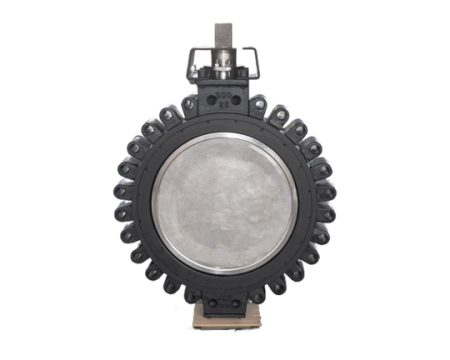
Final thoughts on the future of valve technolog
As we look towards the future, it’s clear that valve technology is poised for significant advancements. The ongoing digital transformation and focus on sustainability are likely to drive innovation in this field, leading to more efficient, reliable, and environmentally friendly valves. The rise of ‘smart’ valves equipped with sensors and wireless capabilities promises real-time performance monitoring and predictive maintenance, reducing downtime and improving operational efficiency. Furthermore, as industries continue to tackle increasingly challenging applications, we can expect to see valves designed to withstand these conditions without compromising their performance. Triple Offset Valves (TOVs), with their unique design and versatility, are likely to play a key role in this future landscape. As we navigate this exciting era of innovation, it will be fascinating to see how these developments shape the industrial sector and contribute to our collective sustainability goals.


